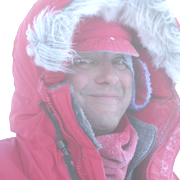|
| Stephen Pekar's Home Page |
||
| Vitae pdf |
I am a geologist with research interests that encompass a wide variety of problems related to Cenozoic climatic change. To tackle these problems, I develop sedimentological, microfossil, and geochemical data obtained from cores that obtained from estuarine, near-shore, and deep-sea locations ranging from the tropics to Antarctica. These are used to extract climatic, oceanographic, and global sea-level signals at the decadal- to million-year scale. My research can be broadly divided into three groups. The first group combines projects that use a new method to constrain global sea-level amplitudes and ice-volume changes in Antarctica that I developed and then implemented for pre-Pleistocene records (>2 Ma). This involves an integrated approach using lithofacies, age control, foraminiferal biofacies, and two-dimensional flexural backstripping. The second group focuses on developing a better understanding of the Cenozoic climatic history of Antarctica by obtaining records located near or on the Antarctic continent. To this end, I have been a member of the ANDRILL (ANtarctic DRILLing) Program for over five years, which "is a multinational initiative that aims to recover stratigraphic core records for interpreting Antarctic's climatic, glacial, and tectonic history for the past 50 Ma". I am part of the ANDRILL Southern McMurdo Sound Drilling Project, which first seismically imaged and then drilled and recovered sedimentary cores as old as 20 million years old that are preserved below the sea bottom. In 2005, I was part of an expedition that collected multi channel seismic data to image sediments preserved below the sea floor. In 2007, I was a sedimentologist on the SMS Project, which recovered over 1,100 meters of sedimentary cores ranging in age from 2 to 20 million years ago. In 2008, I was the lead Principal Inveestigator of the Offshore New Harbor Expedition, which imaged sedimentary archives that extended to when Antarctica was mainly ice free (50-35 million years ago). The goal of this expedition is to locate the optimal site to drill sediments deposited during the Greenhouse World (>35 million years ago), a time when the Earth was much warmer than today and Antarctica was mainly ice free and was covered (at least) along its coastlines. In January 2010, I will be a paleontologist aboard the Integrated Ocean Drilling Project expedition to offshore of Wilkes Land, Antarctica. This expedition aims to recover sedimentary archives from the shelf to the abyssal plain off of Antarctica recovering sediments deposited during the Greenhouse World that are up to 1,000 meters below the sea floor. A third set of projects are aimed at gaining greater insights into paleoceanographic and climatic changes during important warm periods in Earth's history: the early Miocene (21-16 Ma) and late Paleocene (59-55 Ma). These projects use stable isotopes and trace metals to reconstruct climatic and paleoceanographic changes. |
